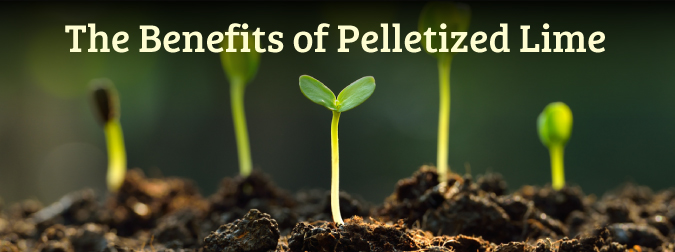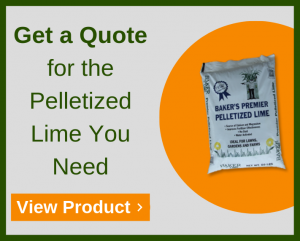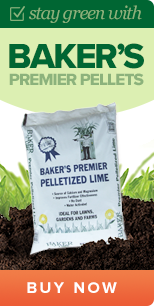Benefits Of Pelletized Lime
Table of Contents
View Our Pelletized Lime Find Your Local Distributor
Author/Reviewed By: Josh Miller, Sales Manager: Baker Lime & North America Minerals
Published: 4/25/2017 – Updated: 10/25/2023
Whether you’re working with a personal garden or running an agricultural business, optimizing your plant health and production is probably one of your biggest concerns. Among the many things needed to guarantee crop health, quality soil is one of the most important. Not only does your soil need to be nutrient-rich, but it must also have a balanced pH. One of the best ways to guarantee your lawn or garden has a healthy pH is with pelletized lime.
What Do Lime Pellets For Lawns Do?
Low pH in soil is actually one of the biggest problems gardeners and farmers face. While many different fruits and vegetable plants tend to do better in these acidic soils, the same cannot be said for other crops. Vegetables like tomatoes, soybeans, squash, asparagus, onions and lettuce, require only mildly acidic soil for the best growth. Mildly acidic soil would be that soil which falls into a pH level of 5.5 to 6.5. Overly acidic soil can cause a host of problems for these plants, chief among which is poor nutrient absorption. Fortunately, there are options available to rectify low pH. If your soil falls below its appropriate range, lime is one of the best ways to raise the pH and help it become more alkaline.
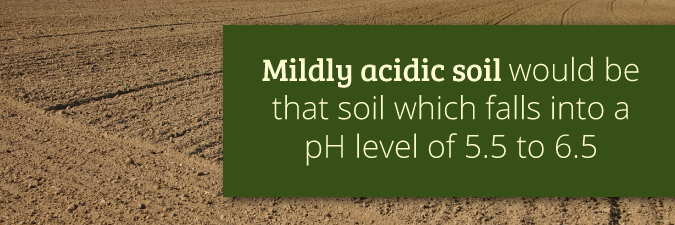
Because lime is a mineral consisting of magnesium and calcium, it has been used for over a thousand years as an easy and accessible way to adjust soil acidity. Adjusting soil with pelleted lime not only increases the pH, but also improves the calcium and magnesium content of the soil, both of which are important nutrients for plant growth and health. Improving soil pH to a more appropriate level also benefits the plant’s growth through improving nutrient absorption, preventing disease and encouraging the growth of beneficial microbes.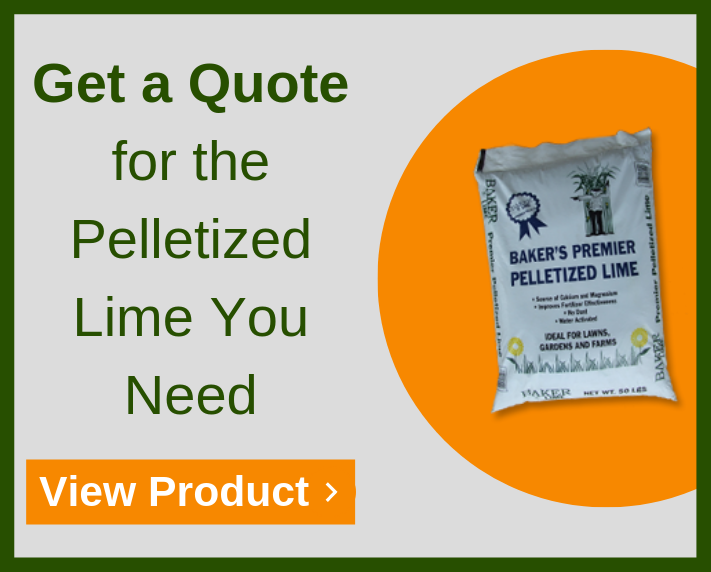
Lime’s soil-regulating ability has made it a particularly popular agricultural and gardening product, and today liming materials are available in a number of forms- each appropriate for certain applications. Some, like fast-acting hydrated and burnt lime, tend to be particularly effective at changing pH quickly. On the other hand, these must be handled with care so as not to create an overly-alkaline environment. Others, like powdered lime or crushed limestone, are slower to act but provide steadier results. One product that has been gaining attention recently is pelletized lime.
With sales of pelletized lime experiencing two to threefold increases in recent years, it’s apparent that gardeners, landscapers and farmers are coming to appreciate and use pelletized limestone as a new and improved way to control soil acidity.
What Is Pelletized Lime?
Pelletized lime for lawns, in essence, is powdered lime that is mixed with an adhesive to form small pellets. The process of making these pellets is very similar to the process of making powdered lime – slabs of limestone are continuously crushed and ground until the stone forms small particles of powdered lime. However, instead of leaving the powder as is, pelletized lime takes the process one-step further, combining the lime with adhesives, called lignosulfonates, to bond the lime particles together and form pellets. These lignosulfonates account for about 9 percent of the entire composition of each pellet, and dissolve in the presence of water. This allows the pelleted lime to take on a powder form once again after exposure to water.
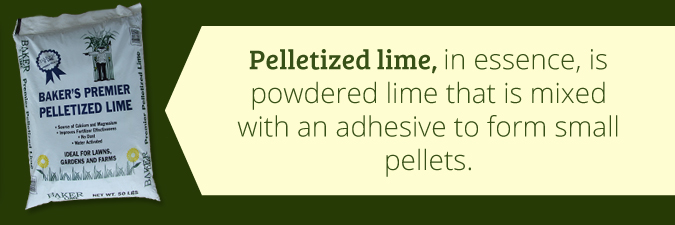
Pelletized limestone has been on the market for years, but lime pellets has only recently started to gain widespread popularity as an alternative to powdered lime. Although pelletized lime has a relatively higher cost than agricultural or powdered lime, it has incredible benefits over other forms. While this higher cost previously deterred people from using pelletized lime, it is apparent that gardeners and farmers alike are seeing the benefits outweigh the cost- even for high-production farmers.
Video – Benefits of Pelletized Lime
How Does Pelletized Lime Differ from Other Lime Options?
When you compare pelletized lime to other types of lime amendments, there are significant functional and practical differences. Some of these differences can be attributed to the effectiveness of the materials. These comparisons are listed in more detail below:
Pelletized Lime For Lawns vs. Agricultural Lime
While pelletized lime and agricultural lime are both applied to soil in a solid form, the two are vastly different in terms of their physical properties and effectiveness.
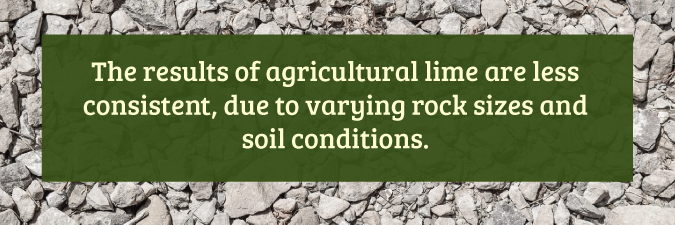
Agricultural lime is characterized by crushed limestone and is therefore very coarse. On the other hand, pelletized lime is powdered before it is pelletized, making it easy to handle and easy to break down. When inserted into the ground, pelletized lime will disintegrate and become powder in the presence of water, acting quickly on the surrounding soil and taking effect for about a year. Agricultural lime, on the other hand, is solid in form, reducing the surface area in contact with the surrounding soil. This means agricultural lime takes much more time to break down and act on the surrounding soil, breaking down over the course of three to five years. In addition, the results of agricultural lime are also less consistent, due to varying rock sizes and soil conditions. Overall, pelletized lime is the more efficient, easier choice.
Pelletized vs. Powdered Lime
Processed limestone, regardless of whether it is applied to soil in powdered or pelletized form, works more quickly on soil than it would in a solid rock form, dissolving quickly into the soil to more immediately affect the pH. While both pelletized lime and powdered lime are manufactured by grinding solid limestone into a fine powder, pelletized lime is even further processed by adding water-soluble adhesives to the mix. This allows farmers and gardeners to easily spread and handle the pelletized material without missing out on the benefits of the quick-dissolving powdered form.
While the functionality of powdered and pelletized limestone are relatively similar, the practicality of these two lime forms is vastly different. Powdered lime has a small particle size, making it less effective at bringing change to soil than pelletized lime. Powdered lime is difficult to apply evenly due to its lightweight and dusty nature. It has a tendency to stick to clothing and shoes and can easily get picked up by the wind. This results in significant waste. The pelletized form of lime on the other hand is a bit more solidified, making it easier to spread and unaffected by the wind. Again, pelletized lime is the better option for efficiency and effectiveness when it comes to adding lime to your lawn or garden.
Lime Pellets vs. Quick Lime
Quicklime is more formally known as calcium oxide or CaO. This substance is significantly more alkaline than any other form of limestone, including pelletized lime. It is produced by heating limestone in a special kiln, which burns carbon dioxide off of the limestone. This then converts the limestone with a molecular structure of CaCO3 to calcium oxide with a molecular structure of CaO. Once converted into this more alkaline form, the calcium oxide is then powdered and packaged for use.
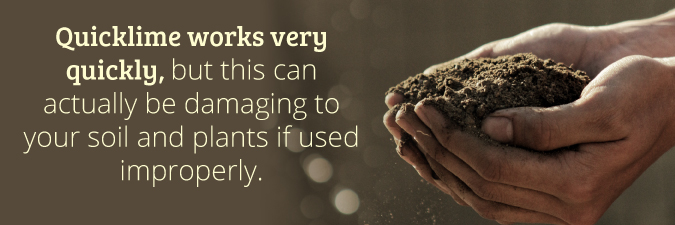
As its name suggests, the advantage to quicklime is that works very quickly, but this can actually be damaging to your soil and plants if used improperly. Additionally, quicklime comes in a powdered form, meaning that it has the same dust-related handling problems as traditional powdered lime. Pelletized lime, on the other hand, is much easier to handle and spread over soil. It is also much less alkaline than quicklime, allowing it to produce more consistent and controlled results.
What Does Pelletized Lime Do for Soil?
All forms of lime are able to create significant change in the soil it is applied to. Benefits of lime include:
• Making Soil More Hospitable: Adjusting soil pH allows gardeners and farmers to grow a wider range of crops in soil that would otherwise be inhospitable to vegetation. This is especially helpful for land near cities and suburbs, as that soil tends to be slightly more acidic due to runoff and pollution.
• Improved Fertilizer Effectiveness:
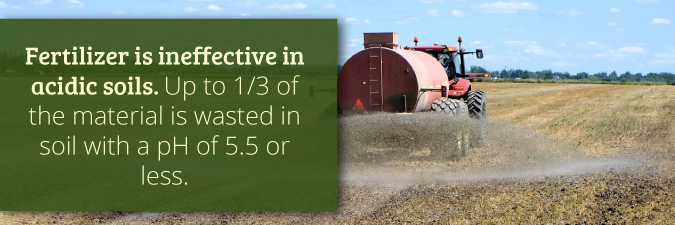
If your soil isn’t the appropriate pH before you apply fertilizer, then you’re simply wasting your fertilizer. Fertilizer is ineffective in acidic soils. Up to 1/3 of the material is wasted in soil with a pH of 5.5 or less. This is because the plants simply cannot take advantage of the nutrients in the soil unless the pH is within the proper range. The problem gets worse the longer you use fertilizer – three years of fertilizer use without limestone can result in soil dropping below a pH of 6.0. However, when controlled with appropriate limestone application, fertilizer can be even more effective.
• Improved Plant Health: Between the improved pH levels and the calcium and magnesium in lime, the nutrients in the soil are more available to vegetation. Appropriate soil pH levels allow plants to more readily absorb nutrients, while calcium and magnesium are both necessary elements for the vegetable and flower production process in plants. Without appropriate lime application, plants might suffer malformations or poor fruit production.
However, the ability of limestone to effectively bring about these benefits depends largely on the qualities of the limestone used. The smaller the particles of limestone, the greater the surface area exposed to the surrounding soil and water. This means that the lime breaks down and starts neutralizing the surrounding soil more quickly than larger particles.
Because pelletized lime is essentially powdered lime combined with water-soluble adhesive, it takes on more user-friendly properties without sacrificing benefits of powdered lime. This quality lends a number of advantages to pelletized lime over other varieties. Just a few advantages of pelletized lime include:
• Better Handling:
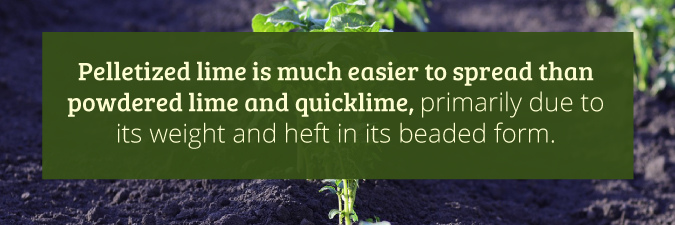
Pelletized lime is much easier to spread than powdered lime and quicklime, primarily due to its weight and heft in its beaded form. While powdered lime has a tendency to dust over one’s hands and clothing or get picked up by the wind, the solidified form of pelletized lime eliminates those dust-related issues. When compared to agricultural lime, pelletized lime is lighter and easier to spread.
• Improved Consistency: Since the weight of the pelletized lime makes it easier to spread, it also improves the consistency and efficiency of lime application as well. The improved weight means lime pellets tend to stay where they fall instead of move around with the wind or other physical disturbances. The result is more evenly alkalized soil, which then improves water retention, nutrient absorption and root systems of plants.
• More Options: In addition to the benefits that pelletized lime naturally offers, the process of breaking down and adding ingredients allows more of an opportunity to create an enhanced product. Additives, like micronutrients and organic acids, are often added to pellets during processing, creating a comprehensive soil solution that contains everything your soil needs to successfully grow.
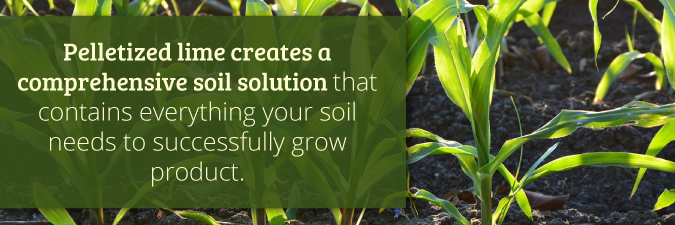
In addition to the benefits that pelletized lime naturally offers, the process of breaking down and adding ingredients allows more of an opportunity to create an enhanced product. Additives, like micronutrients and organic acids, are often added to pellets during processing, creating a comprehensive soil solution that contains everything your soil needs to successfully grow product.
How Do You Use Pelletized Lime?
Pelletized lime can be used in the same places as other forms of lime, but is used largely the same way and manner as powdered lime, including lawns, gardens, flower beds, nurseries, orchards, farms and livestock pastures. Pelletized lime should be applied in the following basic steps:
• Test the Soil: You’ll want to test your soil about three months before you start planting so that you have enough time to finish the test and make changes to the soil, if need be. You can test your soil with a personal testing kit or by sending a soil sample to a testing lab. Either method should allow you to determine the soil type and the pH level. This is an important step you should always do before applying lime to your lawn or garden, to ensure that your soil needs to be treated. Adding lime when it is not needed will result in your soil becoming too alkaline.
• Determine How Much Pelletized Lime to Apply:
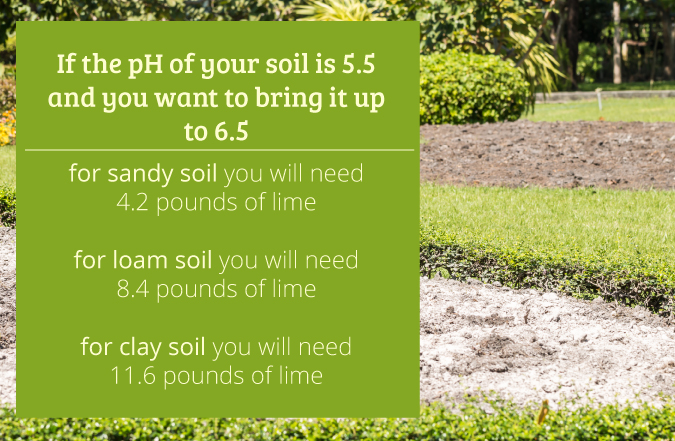
Your garden test, combined with your soil type, should give you an approximate idea of how much lime you need to apply to your soil. If you have clay soil, you’ll need much more lime to bring about significant change, due to the packed-in nature of the soil. If you have sandy soil, you’ll need less lime due to the particulate nature of the soil which allows nutrients and lime to flow much more easily. Loam-type soil is the best of the three, with an equal mix of clay, sand and organic material, loam soil needs only a medium amount of lime to bring about change. For example, if the pH of your soil is 5.5 and you want to bring it up to 6.5, for sandy soil you will need 4.2 pounds of lime, for loam soil you will need 8.4 pounds and for clay soil you will need 11.6 pounds.
• Choose a Time to Lime: Generally, you will want to lime your garden or agricultural land during the spring before planting, or in the autumn after harvest. Many experts suggest liming at the end of the growing season so the lime will have enough time to spread evenly through the soil. Avoid liming when your soil is frosted-over or when your plants have already wilted. Try to lime right before a rainstorm or shower if possible, as this will allow the rain to dissolve the lime and help it soak into the soil. If your soil is particularly acidic, you may want to apply lime on a bi-annual basis. Knowing the best times to lawn your lime will ensure the best results.
• Apply the Lime Pellets: Applying your pelletized garden lime depends largely on your personal preferences and equipment. Powder users will typically use a drop spreader, which is a machine that you push as it sprays powder across the soil. You can usually do the same with pelletized lime, though you also have the option to spread pelletized lime by hand or with a shovel if you desire. Regardless of your method, make sure that you apply your lime pellets for lawns evenly to the soil surface so that every square foot is equally covered. Make sure you use all the lime you have parceled out for the job.
• Till the Lime: You want to make sure your lime is readily available in your soil mix, and the best way to do this is to sink it into the soil. You can do this either by tilling the soil or digging the lime in by hand. You want to dig the pellets in to a depth around four to six inches. Lime will naturally dip this low after a few rainstorms, but your lime will act much more quickly at the root level of the soil if you get it started. This also reduces the chances that your lime pellets or powder will blow away with the wind.
• Wait and Watch:

Lime does take time to start acting on your soil. If you apply it to your lawn, you likely will not see results immediately after application. So how long does it take for pelletized lime to work? Wait for a month or so, or a few weeks after your next rainstorm, to test your soil pH again. Ideally, it should fall into your desired pH range. If it still falls below your ideal range, you can add more lime before the growing season. If the pH is too high, however, you will want to fix it. For immediate results, sulfur is the best bet, as it is most effective at fixing alkaline soil. If the change you need is small or you have time to fix it, however, adding manure or compost to your soil can help bring down the pH while also improving the quality of your soil.
Once you are satisfied with the amount of lime you have added to your soil, you can store any excess lime in a cool, dry area for use next year. Apply pelletized lime to your soil every year to guarantee the improved health of your plants in the long-term.
Where to Buy Bulk Pelletized Lime For Lawns & Farms: Get a Quote For Lime Pellets For Gardens from Baker Lime
When your lawn or garden is suffering from overly acidic soil, you need to act quickly before it starts harming the quality and quantity of your fruits and vegetables. Don’t wait – get the best quality lime for your farm, garden or lawn from Baker Lime.
Since 1889, Baker Lime has been supplying farmers and homeowners alike with the highest quality lime on the market. We mine and process our own lime, taken from our dolomite mines located in the heart of York County, PA. Today, we are one of the most trusted lime suppliers of New England and the East Coast, providing lime for customers across New York, Pennsylvania, Delaware, West Virginia, Virginia, New Jersey, Maryland and more.
For over 125 years, we have built our client relationships on a basis of customer service and quality, developing our reputation for providing every client from any industry with the right limestone products they need to get the job done. Whether you are a homeowner looking to improve the quality of your lawn or an industrial farmer wanting to produce healthier crops, we know and have what you need.
In your search for high-quality limestone at a reasonable cost, we can offer you that and more. Our friendly and professional staff members know everything there is to know about lime and the products we offer. No matter your needs or your questions, our staff members can answer and match you with the best products for your application. Even better, we can provide you with a free quote on any of our lime products!
Collaborate with Baker Lime and take your first steps toward the garden or lawn of your dreams using lime pellets. For more information about our pelletized lime, or to get a price quote for our resources, find and contact our local Baker Lime today!





